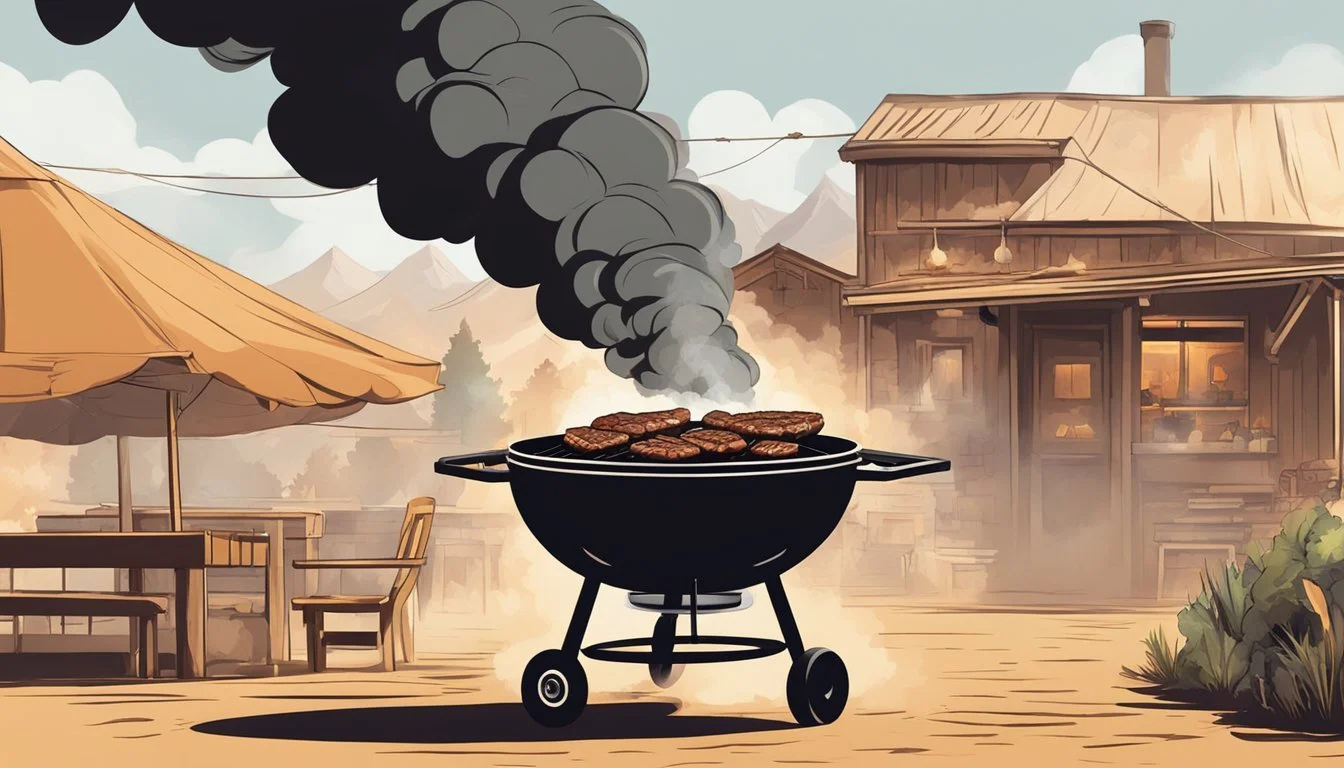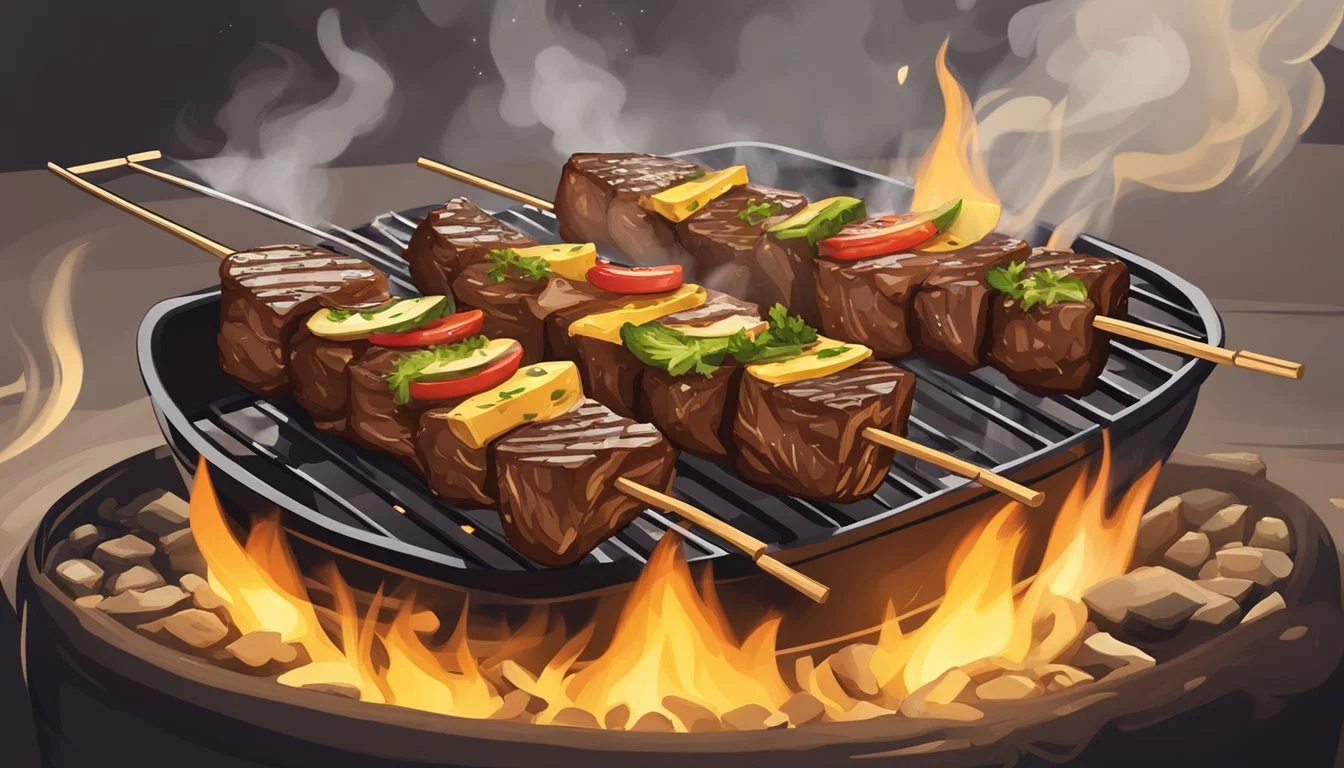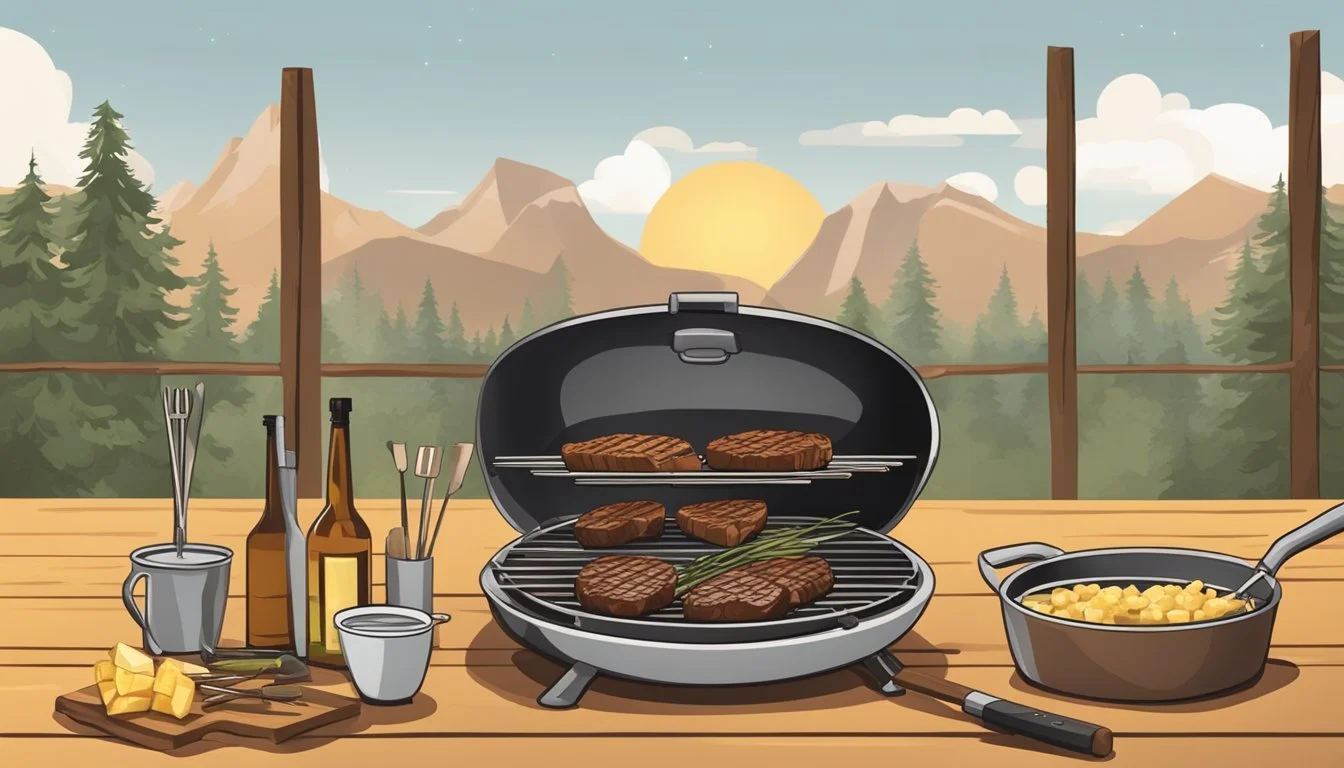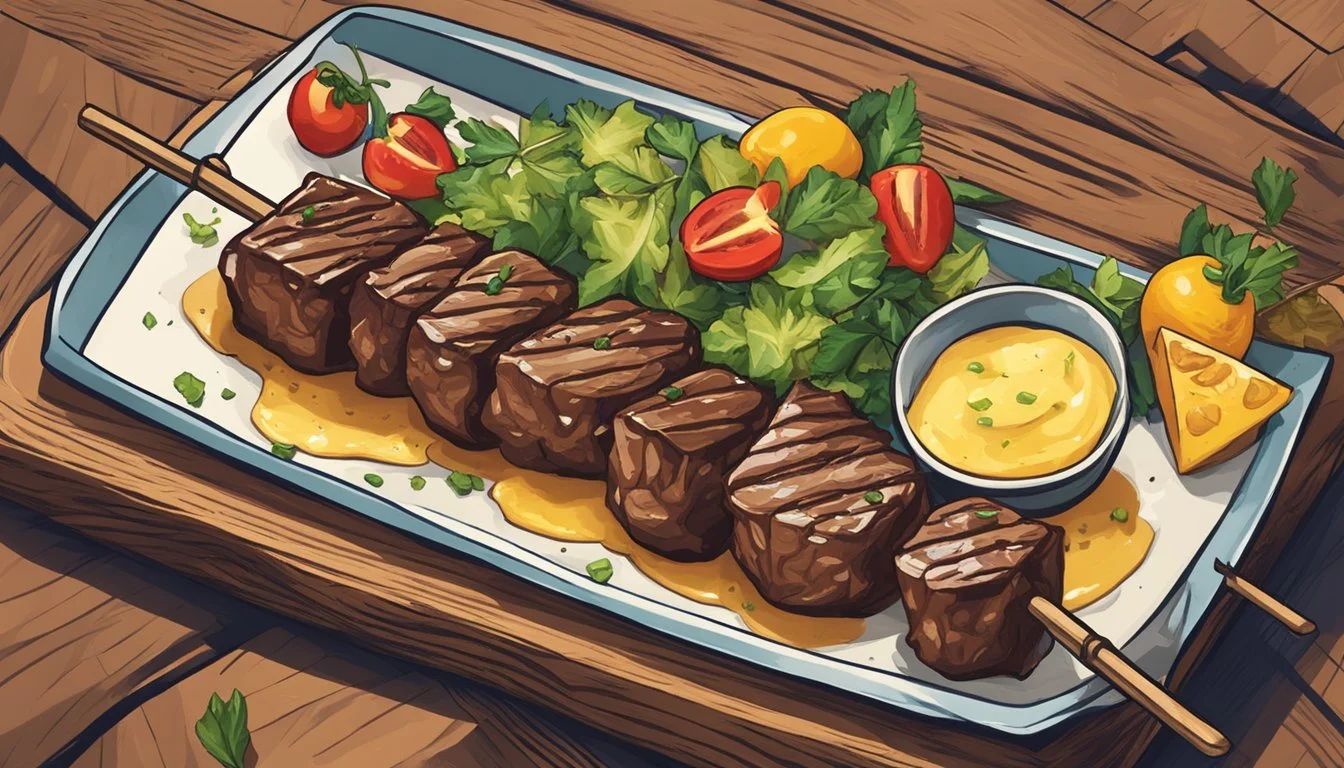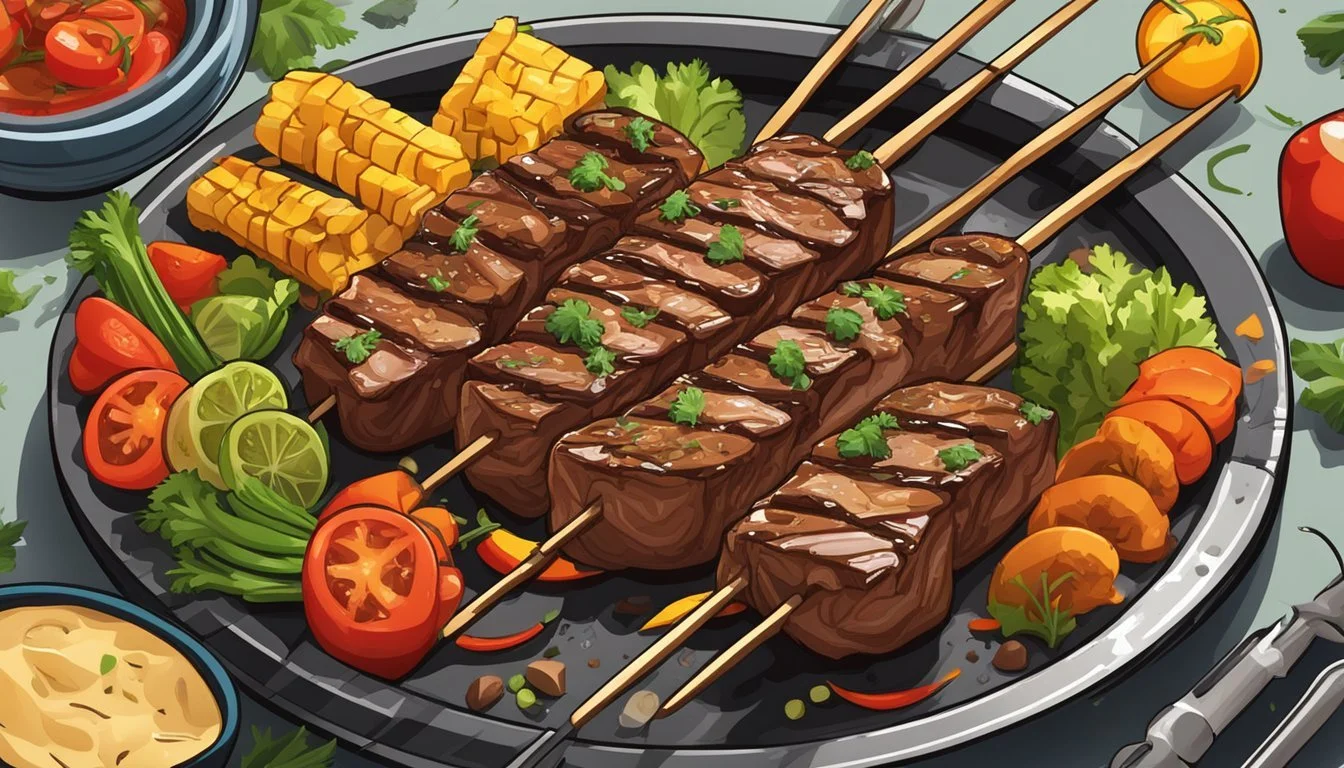Cowboy Butter Steak Skewers
Elevate Your BBQ with Zesty Flavors
Steak skewers take on a new level of flavor when slathered in a rich, herb-infused Cowboy Butter. This culinary creation marries the robust zest of garlic, citrus, and herbs with the classic taste of grilled steak. It emerged from the Western-inspired kitchens and has now become a sought-after grilling companion for meat lovers. The butter, having found fame on social media platforms, boasts a combination of flavors that enhance the natural savoriness of the meat. These skewers are not only bursting with taste but also present a visually appealing dish that's sure to impress at any gathering.
Cowboy Butter Steak Skewers offer a harmonious balance between simplicity and gourmet. The preparation process involves marinating the top sirloin cubes, threading them onto soaked skewers, and grilling them to perfection. The Cowboy Butter, typically a mixture of melted butter, lemon juice, zest, garlic, and a variety of herbs and spices, is then either brushed onto the skewers during the final moments of grilling or served on the side as a delectable dip. This combination promises a grilling experience that's straightforward to prepare yet complex in taste, making it a versatile option for casual cookouts and upscale barbecues alike.
The allure of the skewers lies in their versatility and the ability to infuse the steak with a personalized touch of flavor. Whether one opts for the melt-in-your-mouth tenderness of a well-marinated sirloin or the smoky char of a seared ribeye, the Cowboy Butter serves as the ideal complement. Its components are adjustable to suit individual taste preferences, ensuring that each batch of Cowboy Butter Steak Skewers is as unique as the gathering it's served at. This has transformed a simple backyard barbecue staple into an innovative dish that stands out for its taste and flair.
The Essentials of Cowboy Butter
Cowboy butter elevates simple grilled dishes (What wine goes well with grilled dishes?) to new levels of flavor. It is known for its rich, tangy taste and incorporation of bold seasonings.
Understanding Cowboy Butter
Cowboy butter is essentially a compound butter—butter that's been mixed with additional ingredients to infuse it with distinct flavors. Originating from the culinary traditions of Western America, cowboy butter is often associated with grilled meats (What wine goes well with grilled meats?) and BBQs, admired for its ability to complement beef especially well.
Flavor Profile & Key Ingredients
The assertive flavor profile of cowboy butter is derived from a combination of:
Butter: Acts as the smooth, creamy base.
Lemon Juice and Zest: Provides a tangy, fresh zing.
Garlic: Offers a pungent, earthy flavor.
Parsley and Chives: Introduce a bright herby freshness.
Dijon Mustard: Adds depth with its sharp, tangy taste.
These ingredients together balance zesty citrus with rich butter and aromatic herbs, creating a multi-dimensional taste sensation.
Creating the Perfect Blend
In crafting cowboy butter, care is taken to balance each ingredient effectively. The butter is softened first for easy mixing. Then, the aromatic elements—finely minced garlic, chopped parsley, and chives—are folded in, followed by the zesty components like lemon zest and juice. A touch of Dijon mustard can enhance the complexity of the flavors. The blend should be mixed until even, and refrigerated to allow the flavors to meld before serving.
Choosing the Right Steak
When preparing Cowboy Butter Steak Skewers, selecting the right cut is crucial for tenderness and flavor. The right steak will ensure a mouthwatering outcome that perfectly carries the bold flavors of the Cowboy Butter.
Selecting Quality Meat
For an exemplary skewer, the quality of the meat is non-negotiable. One should seek out steaks with a bright color and firm texture. While the quality can vary, aiming for Choice or Prime grades assures a higher degree of marbling and tenderness. Always prefer fresh over frozen steaks as they maintain better texture and flavor.
Understanding Steak Cuts
Types of steak cuts suitable for skewers include:
Top Sirloin: Moderately tender, top sirloin offers a rich beef flavor and is leaner, making it an excellent choice for skewers.
Flank Steak: While not as tender, flank steak has a bold taste and is more economical. It benefits from marinating prior to grilling.
Chuck Steaks: Usually more affordable, chuck cuts can be used if marinated properly to improve tenderness.
Avoid cuts with a large bone as they are not conducive for skewer preparation.
Marbling and Texture
The presence of marbling, which are tiny streaks of fat within the meat, is synonymous with flavor and juiciness. A good balance of lean meat and marbling is ideal for skewers to ensure they're moist and tender. One should look for steaks with:
Marbling Texture Noticeable but not excessive Firm to the touch Evenly distributed throughout Smooth, not grainy
Steaks like medium-marbled top sirloin strike a perfect balance for skewers. Before grilling, season the meat with kosher salt to enhance the natural flavors and create the perfect steak experience.
Preparation Techniques
Proper preparation techniques ensure steak skewers are succulent and packed with flavor. A meticulous approach to skewering, seasoning, and grilling plays a critical role in the cooking process, impacting both taste and presentation.
Steak Skewering Tips
The first step in creating Cowboy Butter Steak Skewers is to prepare the steak. One should cut Top Sirloin or a similar cut into uniform 1-inch cubes for even cooking. Before skewering, it's essential to soak the wooden skewers in water for at least 30 minutes to prevent them from burning on the grill. When threading the steak onto skewers, leave a small space between pieces to ensure even exposure to the grill's heat.
Seasoning for Flavor Maximization
Seasoning is crucial for enhancing the natural flavors of the meat. Sprinkle the steak cubes with kosher salt and freshly ground black pepper to taste. These simple seasonings lay the foundation for the cowboy butter sauce which significantly amplifies the taste. The cowboy butter sauce combines ingredients such as garlic, lemon juice, herbs, and a pinch of cayenne pepper for a spicy kick. Apply this sauce to the steak before grilling to infuse it with bold flavors.
Skewer Grilling Fundamentals
Grill the skewers over medium-high heat to achieve optimal doneness and flavor. One should grill the skewers for 2-3 minutes per side, checking for doneness as they cook. The goal is to reach an internal temperature of 145°F for medium-rare, using a thermometer to ensure precision. It's important not to overcrowd the grill to allow for proper heat circulation and to turn the skewers occasionally for consistent grill marks and even cooking.
Grilling to Perfection
Grilling steak skewers requires attention to detail to ensure a well-cooked result that maximizes flavor. Here are techniques to master your grilling game, achieve the right doneness, and offer serving tips that enhance the dining experience.
Mastering the Grill
One must choose the appropriate grill for steak skewers, with charcoal grills offering a smokier flavor and gas grills providing convenience and control. To achieve a seared crust on steak skewers, it's essential to preheat the grill to high heat, which should be around 400°F. If using a charcoal grill, distribute the coals evenly to create a consistent cooking environment.
Grill Type Heat Setting Preheat Time Charcoal High 15 minutes Gas High 10 minutes
For a more nuanced approach, the reverse sear method can be employed, where skewers are cooked on a cooler side of the grill before being finished over high heat for a perfect crust.
Achieving the Desired Doneness
Precision is key in grilling steak to the desired doneness. Utilize a meat thermometer to check the internal temperature, removing the guesswork. For reference, medium-rare is typically 130°F to 135°F. When gauging temperature, insert the thermometer into the thickest part of the meat without touching the skewer.
Medium-Rare: 130°F - 135°F
Medium: 135°F - 145°F
Medium-Well: 145°F - 155°F
Avoid cutting into the meat to check doneness, as this can release juices and lead to a drier result.
Resting and Serving Tips
Once the skewers reach the desired temperature, they should be removed from the grill and allowed to rest. This period allows the juices to redistribute, ensuring a moist and tender bite. Rest for at least five minutes before serving. Steak skewers are best enjoyed hot, so if they cool down, a quick reheat on the grill for one minute per side can help restore the ideal temperature without overcooking the meat.
When serving, one might drizzle the prepared Cowboy Butter over the skewers to add a burst of flavor that complements the charred, smoky taste of the grilled steak.
Cowboy Butter Sauce Variations
The versatility of Cowboy Butter Sauce lies in its adaptability to personal taste preferences, be it through adjusting spice levels or experimenting with different herb infusions.
Customizing Your Spice Levels
For those who prefer a mild kick, red pepper flakes provide a controlled but noticeable hint of heat. Start with a quarter teaspoon and adjust according to taste. On the other hand, those seeking more intensity might opt for cayenne pepper, which can significantly elevate the spiciness. Begin with a pinch of cayenne and increase in small increments to avoid overpowering the sauce.
Herb Infusion Variations
The wealth of fresh and dried herbs offers endless possibilities to tailor Cowboy Butter Sauce. For a classic touch, chopped parsley and chopped chives impart a fresh and vibrant flavor, especially when used generously. Alternatively, adding dried thyme can contribute a subtle earthiness that complements grilled steak skewers. Experimenting with different combinations of fresh herbs like parsley or chives and dried ones like thyme can result in a unique flavor profile that enhances the overall grilling experience.
Side Dishes and Accompaniments
When planning a menu around Cowboy Butter Steak Skewers, the selection of side dishes should enhance and balance the rich flavors of the grilled meat and its seasoned butter. Thoughtful pairings will elevate the meal.
Selecting Complementary Sides
One must consider textures and taste profiles when choosing side dishes for Cowboy Butter Steak Skewers. Scalloped potatoes are an excellent choice as they bring a creamy texture that complements the skewers. Another option includes a compound butter with herbs to add a final flourish to simple sides like baked or mashed potatoes.
Scalloped Potatoes: A classic, baked with layers of thinly sliced potatoes, cream, and cheese.
Compound Butter: Infuses additional flavors into veggies or brushed over baked potatoes.
Grilled Veggies and Potatoes
Grilling vegetables alongside the skewers not only streamlines the cooking process but also enhances the overall smoky theme of the meal. Here, one can utilize a variety of vegetables such as asparagus, bell peppers, or zucchini for a colorful and nutritious addition.
Grilled Veggies: Olive oil, salt, and pepper are all that's needed for perfectly grilled asparagus (What wine goes well with grilled asparagus?) or bell peppers.
Potatoes: Baby potatoes can be grilled whole or in halves, seasoned simply or tossed with some of the Cowboy Butter for extra flavor.
Advanced Cowboy Butter Applications
Cowboy Butter, with its robust flavor profile, proves to be not just a companion to the classic grilled steak but an adaptable ingredient lending its taste to a variety of dishes.
Beyond Steak: Versatile Uses
Dipping: Cowboy Butter transforms into a dynamic dipping sauce when melted, perfect for crusty bread, roasted vegetables, or even drizzled over potatoes.
Grilled Steak Skewers: They benefit immensely from a Cowboy Butter baste, which introduces a rich depth as the skewers gain char on the grill.
Spicy Steak Sandwich: When smeared onto a crusty baguette, Cowboy Butter can elevate a spicy steak sandwich by complementing the heat with its garlicky, herby zest.
Beef Recipes: Its application extends into numerous beef recipes, with the butter’s complexity enhancing even simple ground beef dishes.
Horseradish Infusion: For those who desire an extra kick, horseradish can be mixed into Cowboy Butter, pairing exceptionally well with grilled ribeye steak.
Cowboy Butter in Professional Kitchens
Restaurant Usage: High-end steakhouses have adopted Cowboy Butter, adding their proprietary blends to signature dishes, thus distinguishing their flavor profiles in a competitive market.
Steakhouse Innovation: Professional chefs may introduce variants by integrating ingredients such as bourbon or roasted garlic, creating an exclusive offering for restaurant-goers seeking an elevated experience.
Specials and Pairings: Many restaurants also spotlight Cowboy Butter in seasonal specials, particularly in beef recipes that cater to both tradition and a desire for culinary innovation.
Storing and Preserving Cowboy Butter
Cowboy butter, when stored properly, can extend its shelf life and maintain its rich flavors. Precise storage methods ensure that this flavorful compound butter, typically used to enhance steaks, remains fresh and aromatic for future use.
Airtight Storage Solutions
The key to preserving cowboy butter is keeping it in an airtight container. One can store the cowboy butter in the refrigerator for 1-2 weeks. For longer storage, one should place the cowboy butter in the freezer, where it will keep for several months.
To prepare cowboy butter for storage, follow these steps:
Transfer the cowboy butter into a container or wrap it in plastic wrap.
Press the wrap tightly against the butter to remove air pockets.
Seal the container or wrap the plastic tightly around the butter.
Label the container with the current date before placing it in cold storage.
Reheating without Losing Flavor
When reheating cowboy butter, one should be careful to avoid overheating, which could cause the butter to separate and lose its distinctive flavor. The recommended reheating method is to:
Thaw the butter overnight in the refrigerator if it was frozen.
Gently reheat the cowboy butter in a saucepan over low heat, stirring continuously.
Alternatively, one can melt a slice of cowboy butter directly on top of a hot steak, allowing the residual heat to warm it.
By adhering to these storage and reheating guidelines, one ensures that the cowboy butter retains its intended flavor profile, adding a savory boost to any dish when needed.
Safety and Cooking Recommendations
When making Cowboy Butter Steak Skewers, one must prioritize both safety in handling raw meat and ensuring it is cooked to the proper internal temperature.
Handling Raw Meat Safely
One should always handle raw meat with care to prevent foodborne illness. Before and after touching raw meat, it is crucial to wash hands thoroughly with soap and water for at least 20 seconds. Cutting boards, utensils, and surfaces should be cleaned with hot soapy water or a sanitizing solution. To avoid cross-contamination, keep raw meat separate from other ingredients, particularly those that will not be cooked.
Hand Washing
Before handling meat
After handling meat
Surface Sanitation
Clean all contact surfaces
Prevent Cross-Contamination
Use separate utensils and plates for raw and cooked meat
Temperature Monitoring for Food Safety
Gain certainty in the safety and doneness of the steak skewers by meticulously monitoring their internal temperature with a meat thermometer. Steak is safe to consume when it reaches an internal temperature of 145°F, as recommended by the USDA for whole cuts of beef. However, it's essential to allow the skewers to rest for at least three minutes before serving, to let the juices redistribute.
Steak Doneness and Temperature Guide:
Rare: 120-130°F
Medium Rare: 130-135°F
Medium: 135-145°F
Medium Well: 145-155°F
Well Done: over 155°F
One should insert the thermometer into the thickest part of the steak, avoiding bone, fat, and gristle to get an accurate reading.
Using these methods for handling raw meat and monitoring temperatures, diners can confidently enjoy their Cowboy Butter Steak Skewers knowing they are prepared safely and deliciously.
Garnishing and Presentation
When presenting Cowboy Butter Steak Skewers, the visual appeal is as important as the taste. The garnishing and presentation should complement the rich flavors of the butter sauce and spices, creating an impressive and inviting dish.
The Art of Beef Plating
For a visually striking presentation, arrange the steak skewers on a neutral-toned platter to make the colors pop. Drizzle the Cowboy Butter Sauce generously over the skewers, ensuring it cascades down the sides for an appetizing gleam. Sprinkle a dusting of smoked paprika to add a subtle hint of color contrast and smokiness.
Finishing Touches with Herbs and Spices
To finish, scatter a garnish of finely chopped fresh parsley over the skewers for a fresh, vibrant look. The green of the parsley provides a burst of color and a fresh taste that cleanses the palate. If desired, a light sprinkle of chili flakes can be added for those who enjoy a touch of heat. The minced garlic already present in the Cowboy Butter Sauce imparts a rich aroma that invites guests to dig in.
A well-thought presentation elevates Cowboy Butter Steak Skewers from a simple meal to a delightful culinary experience. With these touches, the dish not only tantalizes the taste buds but also captures the diner's eye.
Understanding the Tools of the Trade
Before embarking on the culinary adventure of preparing Cowboy Butter Steak Skewers, one should be well-acquainted with the proper grilling tools and understand the pivotal role a cast iron skillet plays in achieving the perfect sear. It is crucial to select the right equipment to ensure the grilling experience is both enjoyable and yields delicious results.
Choosing the Right Grill Tools
When it comes to grilling, the choice between a charcoal grill and a gas grill can impact flavor and convenience. Charcoal grills are praised for imparting a smoky essence but require a bit more finesse to regulate temperature. Gas grills offer ease of use with adjustable heat settings and quick start-up times. Regardless of the type, quality grilling tools are a must. A set typically includes:
Long-handled tongs: for flipping the skewers
A sturdy spatula: useful for turning larger cuts of meat
A grill brush: to keep the grill grates clean
Meat thermometer: to ensure proper internal temperature
Applying a thin coating of high smoke point oils like olive oil or vegetable oil to the grill grates can reduce sticking and help form an appealing crust on the steak skewers.
Benefits of a Cast Iron Skillet
A cast iron skillet is an exceptional choice for searing steak skewers after they have been grilled. Here's why they are advantageous:
Even Heating: Cast iron provides consistent heat distribution, which is essential for a uniform sear.
Heat Retention: The material retains heat remarkably well, allowing for continued cooking even after removal from the grill.
Versatility: These skillets can be used on the grill for cooking vegetables or sides and are often oven-safe for finishing thicker cuts.
To maintain the skillet's condition and prevent sticking, it should be seasoned properly with oils and maintained with occasional re-seasoning. Regular use can further enhance its non-stick properties, making it an invaluable tool for any grill master.
Nutritional Considerations
When preparing Cowboy Butter Steak Skewers, it's important for diners to take into account nutritional value, especially in terms of saturated fat and sodium content. The use of butter—whether salted or unsalted—plays a crucial role in this consideration.
Balancing Flavor with Health
Butter, a key ingredient in Cowboy Butter, contributes a rich flavor but also adds saturated fats to the dish. Opting for unsalted butter can help manage sodium intake, which is beneficial for heart health. It's worth noting that unsalted butter provides a way to control the overall salt content of the recipe:
Unsalted Butter: 7 grams of saturated fat per tablespoon
Salted Butter: 7 grams of saturated fat per tablespoon, plus added salt
Patrons seeking a healthier version of Cowboy Butter Steak Skewers could look for alternatives that boast similar creaminess and flavor, such as light butter substitutes or olive oil-based spreads, which typically contain less saturated fat. However, changes in ingredients will affect the final taste and mouthfeel of the dish. Those with dietary restrictions should consider portion sizes when enjoying rich dishes like this to keep their intake of fats and sodium in check.
Recipe Variations and Creativity
Culinary artistry thrives on variation, and with Cowboy Butter Steak Skewers, the opportunity for personalization is vast. Chefs can experiment with a range of spices, and flavor profiles to tailor the dish to their palate or cultural heritage.
Infusing Personal Taste
To customize Cowboy Butter Steak Skewers to one's personal taste, individuals may introduce various ingredients such as hot sauce for a spicy kick or brown sugar for a subtle sweetness. The key lies in balancing flavors without overpowering the dish. One could consider the following additions to the Cowboy Butter:
The Citrus Twist: Meyer lemon zest instills a fragrant citrus note.
Sweet Heat: Adding a teaspoon of brown sugar balances the heat with a hint of sweetness.
Bold Spice: Incorporation of hot sauce to desired level gives an assertive flavor.
Exploring Regional Flavors
Regional flavors offer a wealth of creativity. One might incorporate fresh herbs or regional spices in the Cowboy Butter to anchor the dish in a specific culinary tradition:
Southwestern Style: Chipotle powder or cumin to evoke the essence of the desert.
Mediterranean Mood: Mix in oregano and thyme reminiscent of coastal sea breezes.
Asian Flair: A dash of sesame oil and finely chopped green onions adds Eastern influence.
Whether a chef chooses to keep it classic or ventures into innovative territories, these variations on the classic Cowboy Butter Steak Skewers can transform the familiar into an extraordinary culinary experience.

